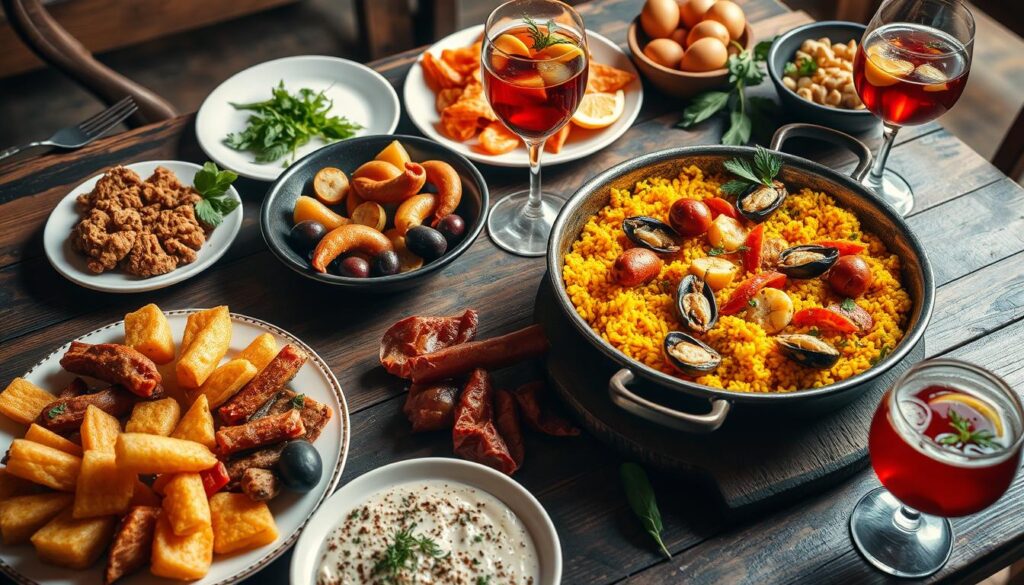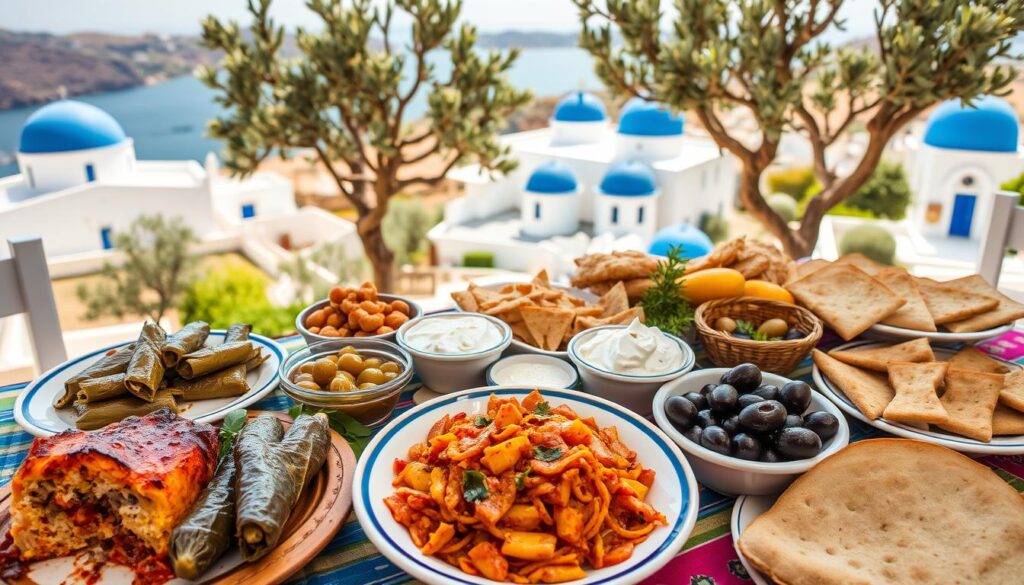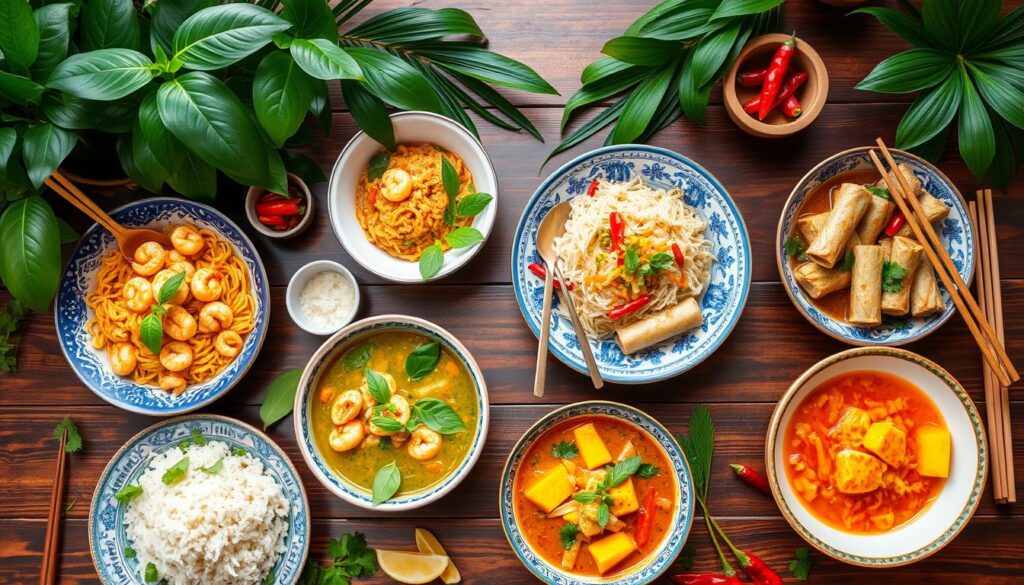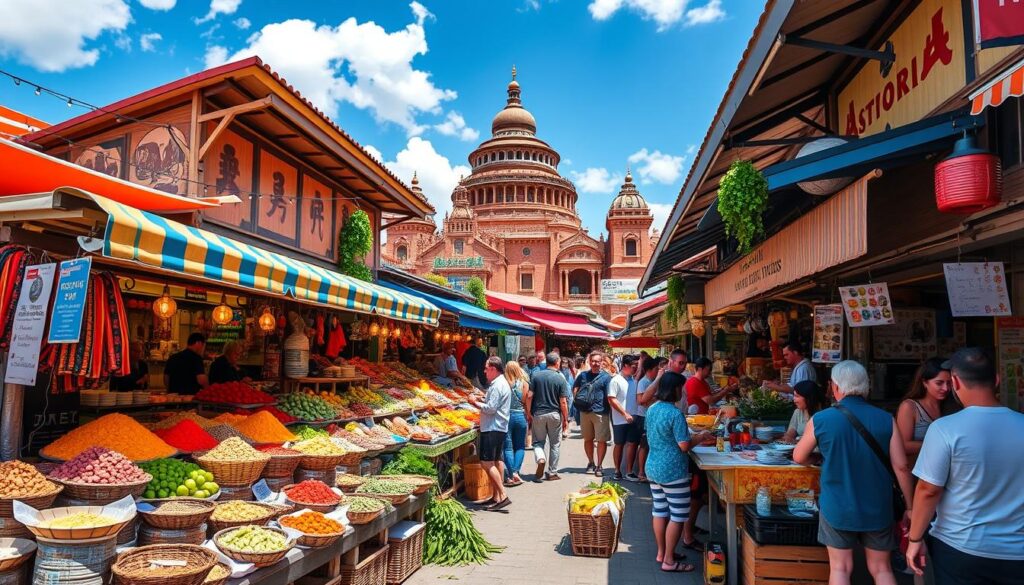Last Updated on: 24th January 2025, 11:26 am
Welcome to a tantalizing journey through global gastronomy, where the art of cooking reveals the heart of cultures and communities around the world. In 2025, we celebrate the culinary destinations that are renowned for their distinctive flavors and rich histories. Here, food serves as a cultural identifier, showcasing the traditions and techniques passed down through generations. From Italy, which dazzles with its pizza, pasta, and gelato, to Mexico, bursting with the vibrant tastes of tacos and mole, each country offers unique culinary treasures. Italy claimed the top spot for the best food in 2016, followed closely by Spain, France, and Mexico, which all continue to enchant food lovers globally, presenting their iconic dishes and signature ingredients12. Join us as we explore these nations that not only satisfy our taste buds but also ignite our passion for food!
Key Takeaways
- Italy is celebrated as a top culinary destination with a rich variety of flavors.
- Spain offers a diverse range of dishes, including famous tapas and paella.
- France stands out for its refined techniques and classic dishes.
- Mexico presents a colorful and festive food culture.
- Greece is renowned for its healthy Mediterranean diet.
Contact us if you are Interested in Buying Property Abroad!
Italy: The Quintessential Culinary Destination
Italy stands out as a leading culinary destination known for its rich heritage and emphasis on Italian Cuisine. Renowned for a wide variety of authentic dishes, Italy captivates food lovers around the world. From the iconic Famous Dishes such as pizza and pasta to delightful treats like gelato, every meal tells a story about the region it comes from.
Famous Dishes: Pizza, Pasta, Gelato
Italian cooking highlights unique regional specialties influenced by local soil and climate. For instance, in Northern Italy, you can savor dishes like Brasato al Barolo, a delicious beef braised in Barolo wine, showcasing the area’s esteemed culinary tradition3. The Caponata features key ingredients such as eggplant and olives, while Carbonara brings together spaghetti and guanciale4. Each plate offers a taste of Italy’s unrivaled mastery in combining fresh ingredients with traditional cooking techniques.
The Essence of Italian Cooking: Fresh Ingredients
At the heart of Italian Cuisine lies the philosophy of using locally sourced, fresh ingredients that align with the Slow Food movement. This commitment to quality enhances every dish, ensuring that it reflects its origins3. Italian dishes like Risotto alla Milanese and Spaghetti with Clams are celebrated examples, with their ingredients sourced from the surrounding landscape and seas4. The diversity found in Italian cooking embodies true culinary excellence, making it a favorite among food enthusiasts worldwide.
| Dishes | Main Ingredients | Region |
|---|---|---|
| Brasato al Barolo | Beef, Barolo wine | Piedmont |
| Caponata | Eggplant, olives, capers | Sicily |
| Carbonara | Spaghetti, guanciale | Lazio |
| Risotto alla Milanese | Rice, saffron | Lombardy |
Spain: A Flavor Paradise

Spain is a vibrant destination renowned for its Spanish Cuisine, which emphasizes flavorful and diverse dishes. Within this culinary landscape, Tapas offer a delightful way to sample a variety of small plates, perfect for sharing and exploring multiple flavors in one sitting. Paella, hailing from Valencia, stands out as an iconic dish, often made with chicken, rabbit, and saffron, showcasing the essence of traditional Spanish cooking.
Diverse Cuisine: Tapas and Paella
The tradition of Tapas is rooted in Spain’s communal dining culture, providing an impressive range of options from savory olives to rich cheeses. Over 150 types of cheese are produced across Spain, enhancing the Flavor Profiles of these small plates5. Paella, in contrast, serves as a rustic yet gourmet representation of Spanish cooking, originating from Valencia and traditionally featuring ingredients like rabbit and saffron5. Notably, Madrid offers unique dishes such as Cocido madrileño, a hearty beef stew, and sweet desserts like rosquillas tontas y listas, sure to entice any dessert lover6.
Iconic Ingredients: Olive Oil and Saffron
Olive oil is a cornerstone of Spanish cooking, essential for preparing many dishes, including Gambas al Ajillo—king prawns cooked with olive oil, garlic, and chili5. The vivid color and aromatic profile of saffron are crucial in dishes like Paella, contributing not only flavor but also the beautiful golden hue that characterizes it. As regions vary from the Basque Country, known for its seafood and Michelin-starred restaurants7, to Galicia with its Galician broth, Spain’s culinary diversity solidifies its status as a flavor paradise6.
France: Home of Culinary Excellence

France stands as a paragon of culinary excellence, where the art of food transcends generations. Known for its traditional techniques, French cuisine is renowned for its high quality and rich history. With an abundance of unique flavors and iconic dishes, France invites both locals and tourists to indulge in its vibrant food culture.
Techniques and Traditions: From Baguettes to Michelin Stars
The culinary landscape of France is a splendid fusion of traditional techniques and innovative practices. French law mandates that a baguette must be crafted using only flour, salt, water, and yeast, which exemplifies the commitment to quality in French food culture8. Regions such as Normandy boast unique products like fine cheeses and high-quality meats, showcasing the diversity of ingredients found across the country9. From renowned Michelin-starred restaurants to charming bistros, the gastronomy here reflects a dedication to culinary artistry that is unmatched on a global scale. In addition to classic techniques like mirepoix and sautéing, braising stands out as a revered method, transforming simple ingredients into sumptuous dishes rich in flavor10.
Classic French Dishes: Escargot and Crêpes
Among the myriad of French delights, dishes like escargot and crêpes capture the essence of this nation’s gastronomic prowess. Escargot, often prepared with garlic butter, reflects the sophistication that French cuisine embodies, while crêpes showcase its versatility, enjoyed both sweet and savory. Paris, the heart of French gastronomy, is home to diverse culinary experiences, from modern tasting tours to traditional meals celebrating regional specialties8. Additionally, France is revered for its cheese production, with nearly 400 varieties proudly representing its rich dairy heritage9. The profound history of French cuisine, influenced by historical culinary practices, marks its identity in the culinary world10.
Mexico: A Festive Food Culture

Celebrated for its vibrant and festive nature, Mexican cuisine offers an incredible array of flavors and culinary traditions deeply rooted in both indigenous and Spanish cultures. During the holiday season, essential foods like tacos, enchiladas, and mole take center stage, showcasing the rich diversity of ingredients found throughout Mexico.
Contact us if you are Interested in Buying Property Abroad!
Essential Foods: Tacos, Mole, and Enchiladas
Tacos are a beloved staple across the country, often filled with mouthwatering grilled meats, fresh vegetables, and zesty salsas. Mole, a complex sauce that can range from sweet to spicy, is another iconic dish that represents the versatility of Mexican cuisine. Enchiladas, rolled tortillas filled with various ingredients and topped with flavorful sauces, further illustrate how traditional recipes create lasting connections among families during festivities.
Food plays an essential role in holiday celebrations, with dishes like bacalao with romeritos becoming Christmas traditions in Mexico’s central region, featuring cod and tiny green seepweed leaves mixed with mole, potatoes, and shrimp11. Tamales, another popular dish, may replace bacalao or turkey as a holiday food option, reflecting Mexico’s diverse culinary customs11. These foods come together to form meal experiences that create memories and celebrate togetherness.
Vibrant Flavor Profiles: Sweet, Spicy, and Savory
Mexican cuisine is known for its bold flavor profiles, where sweet, spicy, and savory notes harmoniously blend. The inclusion of fresh ingredients such as corn, avocados, onions, tomatoes, and chili peppers is characteristic of dishes like guacamole and tamales, contributing to the overall appeal of Mexican cooking12. This cuisine is a tapestry of textures and tastes, as evidenced by the classic representation of dishes such as chiles en nogada, which reflect cultural symbols with their colorful presentations that mimic the Mexican flag12.
As a testament to its rich culinary heritage, Mexico ranks among the top countries with the best food worldwide in 2025. The diversity showcased in dishes such as chilaquiles, pozole, and tacos al pastor highlights the enduring legacy and popularity of traditional recipes that are cherished across generations12.
Greece: A Mediterranean Culinary Delight

Greece stands as a beacon of Mediterranean cuisine, showcasing the rich flavors and traditions rooted in its history. The Greek cuisine is a delightful blend of taste and nutrition, offering a variety of staple dishes that have become renowned worldwide. The culinary practices here reflect the influences of ancient cultures, particularly from the Byzantine and Ottoman Empires, shaping a unique gastronomical experience.
Staple Dishes: Moussaka, Souvlaki, Baklava
Among the iconic staple dishes, Moussaka is a highlight, composed of layers featuring sautéed aubergine, minced lamb, and a delightful mix of spices like cinnamon and allspice13. Souvlaki, another favorite, consists of tender chunks of grilled pork skewered to perfection, making it a popular fast food choice13. For dessert, Baklava steals the show with its flaky filo pastry rich in honey and nuts, epitomizing the sweetness of Greek cuisine13.
Nutritional Benefits: The Mediterranean Diet
The Mediterranean diet is celebrated not only for its delicious taste but also for its significant health benefits. Central to this dietary pattern is the use of olive oil, said to be the elixir of Greece, which is used generously in cooking and dressings13. Meals are typically accompanied by local olives, often preserved in sea salt brine, adding depth to the flavors13. Incorporating staple dishes made predominantly of fresh vegetables, legumes, and whole grains promotes healthier eating habits while remaining satisfying and flavorful14.
Thailand: A Balance of Flavors

Thailand stands out in the culinary world for its intricate balance of flavors, making it a must-visit destination for food enthusiasts. The country’s food culture is vibrant, with an impressive variety of Signature Dishes that reflect the local love for Fresh Ingredients. From street stalls to high-end restaurants, the options are varied, providing a taste experience that is both exciting and diverse.
Signature Dishes: Pad Thai, Green Curry, Tom Yum
Among the most popular dishes, Pad Thai shines as a national favorite, showcasing Thailand’s knack for combining sweet, sour, salty, and spicy elements15. Other standout meals include green curry and Tom Yum, which highlight the unique blend of flavors characteristic of Thai cuisine15. The use of aromatic herbs, spices, and ingredients such as chili peppers and lemongrass elevate these dishes to culinary artistry16.
The Art of Thai Cooking: Fresh Ingredients and Spices
Thai cooking places a heavy emphasis on Fresh Ingredients, utilizing seasonal produce to enhance flavor profiles and create delightful combinations16. Fruits such as mango, jackfruit, and rambutan are often found in various dishes or enjoyed fresh to complement savory meals16. With bustling cities filled with cafés, street vendors, and restaurants available around the clock, dining in Thailand is a rich experience that caters to every taste and budget16. Visitors often discover a growing appreciation for Thai dishes after immersing themselves in the local food scene, frequently opting for these vibrant flavors long after their trip concludes16.
Countries With The Best Food: A Global Perspective

Culinary diversity showcases how food serves as a cultural identifier across the globe. Each nation holds a unique culinary capital, representing its rich history and traditional practices. The increasing interest in culinary tourism highlights this connection, with the global industry valued at $804.95 billion in 2022 and projected to reach $3.28 trillion by 2031, reflecting a compound annual growth rate of 16.9%17. Travelers are prioritizing food experiences, with 53% of leisure travelers identifying as food travelers according to the World Food Travel Association (WFTA)17.
Exploring Culinary Diversity Around the World
Countries like Portugal and Italy offer a glimpse into the rich tapestry of culinary traditions. Portugal boasts one of the oldest culinary cultures in Europe, with its first recipe book dating back to the 16th century18. Similarly, Bologna stands out as Italy’s culinary capital, celebrated for its unique regional foods18. The influence of geographical factors, like the Atlantic Ocean on Portugal’s seafood dishes, emphasizes how local resources shape national cuisines18.
Food as a Cultural Identifier
Food also acts as a cultural identifier, linking people to their heritage. For instance, Naples’ sweet tomatoes, grown in the fertile volcanic soil of Mt. Vesuvius, are essential to the iconic Neapolitan pizza18. Additionally, interests in organic foods are surging, seen in the U.S., where organic food sales jumped from $26.9 billion in 2010 to $52.0 billion in 202117. These trends illustrate how cuisine not only satisfies hunger but also fosters connections among individuals, communities, and cultures.
Japan: A Tradition of Precision
Japan has earned a distinguished reputation in the global culinary world, showcasing a remarkable tradition characterized by precision and artistry. Renowned for its fantastic Japanese cuisine, this cultural landscape features iconic foods like sushi, ramen, and tempura, which collectively embody the essence of quality ingredients and culinary techniques. The meticulous attention to detail found in each dish not only reflects the skill of the chefs but also offers diners a unique sensory experience.
Contact us if you are Interested in Buying Property Abroad!
Iconic Foods: Sushi, Ramen, Tempura
Sushi, a staple of Japanese cuisine, combines vinegared rice with various fresh toppings, often seafood. Acclaimed for its delicate flavors, sushi reflects the Japanese emphasis on natural ingredients and the seasonality of produce. Ramen, on the other hand, is a hearty and diverse noodle soup, offering a variety of broths and toppings that cater to different palates. Tempura showcases crispy battered vegetables and seafood, revealing Japan’s adeptness at transforming simple ingredients into artistic culinary masterpieces.
Not only has Japanese food gained widespread acclaim, but it has also become a profound cultural identifier, leaving lasting impressions and memories due to its storytelling nature19. The flavors range from the subtle umaminess of miso soup to the bold spiciness of wasabi, appealing to a wide audience19. Seafood preferences date back to the ancient periods, where later influences helped cultivate a diet rich in variety and nutrition20.
The Aesthetic Aspect of Japanese Dining
Dining aesthetics play a pivotal role in Japan, where the presentation of dishes elevates the overall dining experience. The principles of kaiseki, the most formal dining style, emphasize a harmonious balance between flavors, colors, and textures, illustrating the importance of seasonal ingredients. Chefs meticulously craft these meals with an artistic touch, ensuring that each component serves as a feast for the eyes21. This attention to aesthetics not only enhances enjoyment but also reflects the cultural significance placed on beauty and simplicity within Japanese cuisine.
In recent years, Japanese cuisine has evolved into a lucrative sector, particularly in Western markets, showcasing the impact of cultural exchanges through anime and pop culture19. As the distinct flavors and aromas of Japanese food gain global traction, the availability of Japanese restaurants and specialty food items continues to grow, further cementing its place in the culinary scene19.
India: A Spicy Adventure for Your Taste Buds
Indian cuisine is a vibrant exchange of flavors and textures, inviting food lovers to explore its vast, diverse offerings. This culinary landscape is characterized by its rich heritage, showcasing an incredible variety of regional variations that cater to all tastes.
Regional Variations: From North to South
Spanning the length and breadth of India, regional variations illustrate the country’s culinary wealth. Northern India boasts flavorful dishes like biryani and butter chicken, while the South delights in sambars and dosas. Regions like Mumbai pamper taste buds with a lively street food culture featuring snacks such as Vada Pav and Pav Bhaji, indicative of the city’s dynamic spirit22. Delhi’s fine dining embraces creativity, offering innovative dishes like Blue Cheese Naan22.
Core Ingredients: Spices, Lentils, and Grains
The heart of Indian cooking lies in its core ingredients. Spices such as cumin, coriander, and turmeric are key elements, infusing dishes with aromatic depth and health benefits23. Lentils and various grains serve as staples, reflecting India’s agricultural traditions and providing a nutritionally balanced meal. Spice mixtures, including Garam Masala, enhance versatility in Indian cuisine while gourmet chutneys and pickles add layers of flavor to meals, making eating an experience24.
Furthermore, the presentation of meals and ingredients plays a vital role in the cultural experience, transforming simple dishes into festive offerings. Whether it’s artisanal snacks or organic tea assortments, the variety available ensures that Indian cuisine leaves a lasting impression, making it a delightful adventure for those eager to explore its rich culinary tapestry24.
China: A Culinary Wonderland
China stands out as a remarkable destination for food enthusiasts, offering an incredible variety of culinary experiences that reflect the nation’s rich history and diversity. The variety of regional specialties available throughout the country encompasses iconic dishes such as Peking Duck and Dim Sum.
Regional Specialties: Peking Duck, Dim Sum
Among the celebrated regional specialties of Chinese cuisine, Peking Duck is renowned for its crispy skin and tender meat, often served with pancakes and hoisin sauce. Dim Sum, another cornerstone of Chinese food culture, features a delightful array of small dishes that include dumplings, buns, and other tasty morsels, ideal for sharing. Visitors to places like Beijing’s Wangfujing Snack Street can also discover a wide variety of exotic food options, including deep-fried crunchy insects such as scorpions and grasshoppers25. In addition, this vibrant street offers lamb and chicken kebabs, fried dumplings, and adventurous local delicacies, proving that diversity is at the heart of Chinese culinary traditions25.
The Role of Flavor Balance in Chinese Cuisine
The complexity of Chinese cuisine lies in the meticulous flavor balance achieved through the harmony of ingredients and cooking techniques. Chefs emphasize the importance of balancing sweet, sour, salty, and spicy flavors to create dishes that cater to varied palates. A. Wong, a two Michelin-starred restaurant in London, showcases this culinary philosophy by offering a multi-sensory journey that reflects the diverse influences of China, evidenced by its fourteen-course tasting menu26. Each dish thoughtfully highlights the fourteen international borders that play a role in shaping the unique flavors and culture of Chinese cuisine, ensuring an experience that lasts approximately three hours26. Visitors often find that the elegance of the restaurant’s dishes mirrors the artistic flair seen in traditional acrobat shows in Beijing, where skilled performers captivate audiences25.
Brazil: A Melting Pot of Flavors
Brazilian cuisine serves as a vibrant reflection of the country’s eclectic cultural influences. It uniquely interweaves elements from indigenous, African, and Portuguese traditions, forming a culinary identity as diverse as its people.
Signature Dishes: Feijoada and Picanha
Among Brazil’s most celebrated dishes, feijoada stands out as the national dish. This hearty black bean stew typically includes a variety of meats, offering a rich and flavorful experience that is surprisingly comforting. Picanha, a prime cut of beef, is another favorite, known for its tenderness and juiciness, often enjoyed at Brazilian barbecues known as churrasco.
Brazilians enjoy this unique blend of flavors, showcasing their fondness for fresh ingredients. Rice and beans serve as fundamental components consumed nearly daily, illustrating how integral these staples are to Brazilian cuisine27. Churrasco originated with the indigenous tribes, showcasing traditions that have persisted for centuries28.
Cultural Influences: Indigenous, African, and Portuguese
The cultural influences on Brazilian cuisine are profound. Over 5 million Africans were brought to Brazil through the slave trade, significantly impacting the food landscape with rich flavors and cooking techniques28. This influence is reflected in the emergence of various restaurants throughout Brazil, including Haitian and Congolese establishments that continue to diversify the culinary scene29. Furthermore, Brazil holds the title of the world’s second-largest producer of beef and sixth-largest consumer of red meat, underscoring the significance of meat in its culinary practices27.
This amalgamation of cultures is evident not only in the food itself but also in the dining experiences around the nation. Brazil’s cultural diversity allows for an array of exotic fruits and unique dishes to be found on tables across the country, demonstrating the endless culinary possibilities that this vibrant culture has to offer.
Conclusion
In our exploration of the top countries with the best food, we’ve journeyed through diverse culinary landscapes, from the rich flavors of Italy to the spicy adventures in India. Each destination offers unique dishes that highlight local ingredients and traditions, showcasing the beauty of cultural connection through cuisine. For food lovers, this journey is more than just a taste test; it’s an invitation to embrace the world’s diverse palate and culinary exploration.
As we’ve discovered, enjoying the array of global flavors is not only about nourishing the body but also about understanding the societies that created them. The data reveals pressing issues surrounding food security, with over 309 million people affected globally30. Therefore, indulging in these culinary delights also means recognizing the responsibility we hold in advocating for sustainable food systems and social equity around the world.
Now is the time to take action, to engage in epicurean adventures that extend beyond your kitchen. By celebrating the vibrant identities of each nation’s cuisine, we can appreciate not just the food but the stories and histories that enrich our dining experiences. So whether you’re savoring sushi in Japan or indulging in a rich mole from Mexico, remember, every dish is a doorway to new cultures and shared human experiences.
Contact us if you are Interested in Buying Property Abroad!
FAQ
What are the top countries known for their exceptional food?
What makes Italian cuisine so special?
How does Spain’s culinary scene differ from others?
Why is French cuisine considered the heart of culinary excellence?
What is unique about Mexican cuisine?
What defines Greek culinary traditions?
What highlights Thai cuisine?
How does food act as a cultural identifier?
What can you tell me about Japanese dining customs?
What regional variations exist in Indian cuisine?
What makes Chinese cuisine diverse?
How does Brazilian cuisine reflect its cultural influences?
Source Links
- https://worldpopulationreview.com/country-rankings/what-country-has-the-best-food
- https://www.cnn.com/travel/article/world-best-food-cultures/index.html
- https://www.chefdenise.com/all/what-to-eat-in-italy-1
- https://www.eatingeurope.com/guides/best-food-in-italy/
- https://jaywaytravel.com/spain/travel-guide/best-spanish-food
- https://www.spainlesstraveled.com/blog/best-food-in-spain
- https://leisuregrouptravel.com/spains-foodie-paradise/
- https://www.contexttravel.com/blog/articles/top-neighborhoods-for-food-in-paris-with-recommended-paris-food-tours
- https://exquisite-taste-magazine.com/regional-french-cuisine/
- https://brasseriedumonde.com/authentic-french-cuisine-unraveling-the-flavors-techniques-and-history/
- https://mattitos.com/blog/typical-foods-served-during-the-christmas-season-in-mexico/
- https://www.bbcgoodfood.com/travel/global/top-10-foods-try-mexico
- https://www.bbcgoodfood.com/travel/europe/top-10-dishes-try-greece
- https://www.theblackolive.com/what-are-the-top-mediterranean-food-countries
- https://www.gocollette.com/en/traveling-well/06/asia-countries-best-food-culture
- https://teanabroad.org/blog/thailand-of-food/
- https://finance.yahoo.com/news/15-countries-best-food-quality-083403420.html
- https://www.travlinmad.com/blog/travel-for-food-and-wine-destinations
- https://www.sanraku.com/why-is-japanese-food-so-popular/
- https://www.worldhistory.org/article/1082/food–agriculture-in-ancient-japan/
- https://www.eater.com/2017/9/7/16244278/japanese-fine-dining-bocuse-tsuji-kaiseki
- https://www.adventure-life.com/travel/articles/the-ultimate-guide-to-eating-your-way-through-india-1
- https://hogr.app/blog/the-vibrant-world-of-indian-street-food-a-culinary-adventure/
- https://indiashopping.io/blogs/news-1/top-10-indian-food-gifts-that-will-delight-your-taste-buds?srsltid=AfmBOopHhNBiUxhZQ2ehMa5x3cQhis9XNyycUSd462GMYQav-g6hTX1O
- https://alisonanddon.com/2019/05/01/weird-meals-and-fearless-wheels-street-food-and-acrobats-in-beijing/
- https://beaumondetraveler.com/content/a-culinary-journey-of-exploration-celebrating-the-regions-of-china-at-a-wong-london/
- https://uncoversouthamerica.travel/blog/the-most-famous-and-traditional-dishes-in-brazil/
- https://danazia.wordpress.com/2016/08/30/the-wild-melting-pot-called-brazil/
- https://www.americasquarterly.org/fulltextarticle/brazils-new-melting-pot/
- https://www.wfp.org/ending-hunger
Best Countries According to Aparthotel.com
- Best Countries To Live In Europe
- Best Countries To Move To From Canada
- Best Country To Live In
- Top Birth Tourism Countries
- Cheapest Asian Country To Live In
- Cleanest Country In The World
- Countries With No Capital Gains Tax
- Countries That Allow Dual Citizenship
- Countries With No Income Tax
- Countries With No Inheritance Tax
- Countries With No Property Tax
- Easiest Countries To Move To From USA
- Easiest EU Country To Get Citizenship
- Hardest Countries To Immigrate To
- Highest Tax Paying Country
- Instant Citizenship Countries
- Least Corrupt African Countries
- Lowest Tax Countries
- Non Extradition Countries
- Safest Countries In Africa
- Safest Countries In Europe
- Safest Country In Asia
- Safest Country In The World
- Safest Latin American Countries
- Second Passport Countries
- Territorial Tax Countries
- Which Country Pays Highest Salary
- Most LGBT Friendly Countries
- Best Countries For Expats
- Best Countries for Work-Life Balance
- The Best Countries For Hiking Adventures
- Best Countries for Expat Healthcare
- Safest Countries For Women Travelers
- The Best Country For Safari Adventures
- Top Solo Travel Destinations for Adventure Seekers
- The Best Solo Trips For Women
- Best Countries For Disabled Veterans
- Top Countries for Plastic Surgery
- Top Countries for All Inclusive Resort Vacations
- Top Countries With The Best Food Worldwide
- Best Countries For Black Expats
- Top Countries for Education
- Best Places To Retire In The World
- Top Countries for Transgender Expats to Live
- Best Places For Passport Bros
- Top 10 Best Countries For Surfing
- Top Countries for Digital Nomads
- Top European Countries for English Speakers to Live
- Top Countries for Software Engineers to Thrive

As a passionate, global-thinking Real Estate Investor I am constantly looking for the best opportunities to invest in Properties. With Aparthotel.com I am building an All-In-One Global Real Estate Platform, where people can analyse, rent or invest in properties. Additionally I help Investors with comparing the best financing options as well as give detailed Consultation on the buying process for Real Estate Investments around the world. I am looking forward to sharing my knowledge on this Website and feel free to reach out to me if you have any questions.

Comments